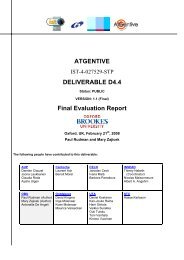pdf 820Kb - INSEAD CALT
pdf 820Kb - INSEAD CALT
pdf 820Kb - INSEAD CALT
Create successful ePaper yourself
Turn your PDF publications into a flip-book with our unique Google optimized e-Paper software.
Evaluation report of the use of Onto-Logging<br />
platform in the user site<br />
Deliverable ID: D8b<br />
Page : 31 of 110<br />
Version: 1.0<br />
Date: 27 january 2004<br />
Status: Final<br />
Confid.: Public<br />
• Assess the functionalities of what has been designed (summative).<br />
• Assess the substantive value of what has been designed (substantive value).<br />
In the first case, formative evaluation will help to readjust the plans and the priority of the<br />
Ontologging project, to better understand the users’ needs, and to refine the definition of the<br />
different Ontologging components, putting more emphasis on what is considered to be the<br />
most important.<br />
This phase will first be based on setting-up at the user place an early version of the prototype,<br />
and asking them for their feedback. This phase will also consist in evaluating how the<br />
different components interoperate with one anot her, and in identifying the functionalities that<br />
may be missing, or that would need more attention.<br />
In the second case, summative evaluation will help to access what Ontologging has produced,<br />
and what are the functionalities available.<br />
This phase will consist in the evaluation of the main Ontologging components at the users’<br />
site, and will be achieved with a functioning version of the prototype.<br />
In the last cases, the substantive value evaluation will help to understand what are the areas of<br />
knowledge management in which the system can contribute the most, and where is the real<br />
innovation (incremental or radical) in the Ontologging system.<br />
This phase will consist in the analysis of the different components of Ontologging according<br />
to a usability perspective (what is really usable for the organization). This phase will be<br />
achieved using the result of a consolidated version of the prototype<br />
3.3.4 A pre-selection of the elements to be evaluated<br />
Let’s now define, for each of the sub-goals that we want Ontologging to achieve, some<br />
elements and criteria to evaluate.<br />
3.3.4.1 Goal 1: Ontologging for helping to structure the work in the organization<br />
The structuring role of Ontologging originates from its capability to support the definition of<br />
the shared Ontologies that specify the semantic of the different concept and that are used<br />
across the whole organization to communicate.<br />
Several elements can be taken into account when evaluating the capability of Ontologging to<br />
support this structuring role.<br />
Technical view<br />
The first element is the technical and instrumental, and is related to the capability of the<br />
Ontology authoring tools that are provided, to support the definition of the different<br />
Ontologies that need to be represented. The evaluation of this element mainly consists in the<br />
evaluation of the technical components that are used to author the ontologies (these
















